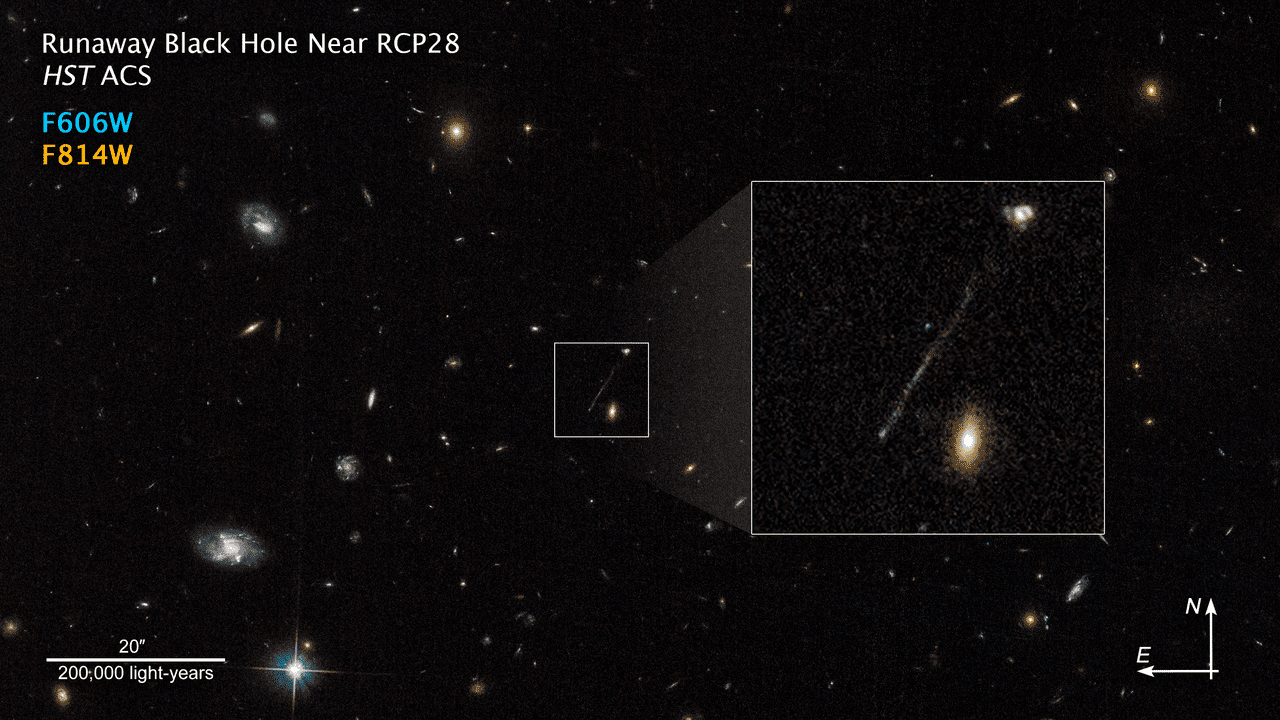A 200,000 light-year-long trail of bright stars has been found stretching between a distant galaxy and a curious formation. After close examination astronomers have concluded what we are seeing is a hyper-fast black hole plowing through intergalactic space. The black hole’s passage is compressing the diffuse gas that exists even between galaxies enough to start star formation, the discoverers think – something we have never seen before.
When the Hubble Space Telescope took an image containing a thin line stretching from unnamed galaxy billions of light-years away astronomers wrote it off as an error. Cosmic rays entering the camera can look like scratches, making streaks in unexpected places easy to dismiss.
Fortunately, Yale’s Professor Pieter van Dokkum was looking through archival Hubble images seeking globular clusters around the nearby dwarf galaxy RCP 28 and came across the one below. On closer examination, he realized the line was unlike anything scientists have seen before in all our studies of distant galaxies. In a new paper, van Dokkum and co-authors reveal the consequences of a high-speed escape by a supermassive black hole.

The archival Hubble image with the streak of stars expanded for clarity. It’s easy to see why this was missed, overshadowed as it was by brighter galaxies. Image credit: NASA, ESA, Pieter van Dokkum (Yale) IMAGE PROCESSING: Joseph DePasquale (STScI)
The image van Dokkum examined shows a distant galaxy, with a thin line of stars stretching twice the length of the Milky Way galaxy towards something bright. The line of stars is far too bright and thin for its length to be an intergalactic gas bridge. The source galaxy has less than 1 percent of the mass of the Milky Way, but is forming new stars roughly as fast, probably because of a recent merger.
The paper concludes the trail could only be created by a very massive and fast-moving object creating a ripple effect in its wake. The authors anticipate a mass 20 million times that of the Sun, and five times the Milky Way’s Sagittarius A* black hole. The trail has been created in approximately 39 million years, indicating its maker is moving at 1,600 km/s, a speed sufficient to cross the gap between the Earth and Moon in 14 minutes or reach the Sun in 26 hours.
“We think we’re seeing a wake behind the black hole where the gas cools and is able to form stars. So, we’re looking at star formation trailing the black hole,” van Dokkum said in a statement.
The authors liken the effect on the gas it has passed through to a contrail of water vapor condensing behind an airplane under the right atmospheric conditions. The trail is almost half as bright as the galaxy it comes from, a consequence of the gas collapsing into a few very massive stars that become intensely luminous for very short periods – astronomically speaking.
There is also a very bright area around the black hole, which the authors attribute to either gas heated by the shock of the black hole’s arrival, or the accretion disk around the hole.
“This is pure serendipity that we stumbled across it,” van Dokkum said. If the cosmic bridge hadn’t been in the same part of the sky, but hundreds of times more distant, than the galaxy he was studying it would not have been found.
This black hole is a million times too massive to be expelled by a supernova explosion, as happens to runaway stars. The only plausible explanation is the interactions between three merging galaxies’ supermassive black holes.
Just as a third star can displace one member of a binary system, when two black holes orbit each other the arrival of a third can slingshot the lightest of the three out of the system. The other two remain in orbit around each other, while heading in the other direction at a more stately pace.
Finding the black hole pair would confirm the theory and a suspect has been found that will require further study to confirm.
The system is so fascinating that precious time has been booked on both the JWST and the Chandra X-Ray observatory to explore it in more detail. Other “scratches” written off as gamma-ray interference will also be re-examined to see if the phenomenon is unique.
The study is open access in The Astrophysical Journal Letters
Source Link: Hubble Spots A Suspected Black Hole On The Run, Trailing Stars